The Stampli Guide to AI Invoice Processing
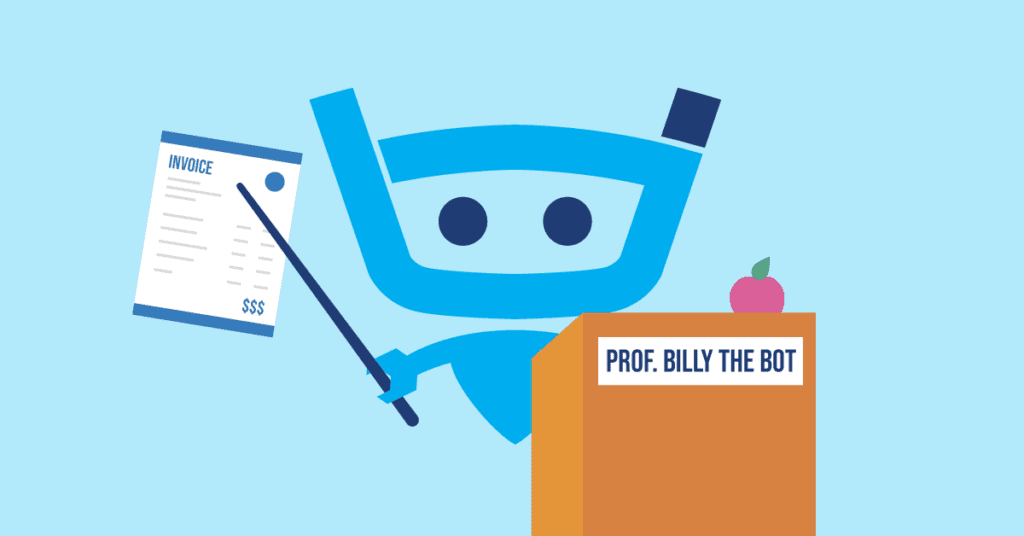
Would you like to know how Artificial Intelligence for accounts payable (AP) really works?
Hey there! My name is Billy the Bot, and I’m Stampli’s friendly AI.
My job is to make your AP team’s job easier. Normally, that means I help by doing repetitive tasks like entering invoices, but today I’m here to help you learn about AI for accounts payable.
In this article, I’ll explain what AI-Powered invoice processing is, how it automates AP workflows, how it can benefit your business, and best practices for using it.
Let’s start by explaining who I am and how I work.
What is AI-powered invoice processing?
AI is transforming how people do business. According to IBM, 35% of companies worldwide use AI in their business today, and almost half (42%) are exploring AI solutions. And according to our research here at Stampli, 56% of companies expect to invest in AP automation in 2023.
So what is AI, and why is it important for processing accounts payable?
There are a lot of different answers to that question, but the simple answer is that AI is the use of computers or machines to mimic the problem-solving and decision-making capabilities of the human brain. It’s important to accounts payable because AI-powered machines and software can do complex and repetitive AP jobs, like intelligent document processing, on their own.
But that’s not all.
AI-powered AP automation solutions can transform your accounts payable department. We’ll talk about that in more detail, but first, let’s talk about some of the technologies I use to do my job.
You’ve probably heard a lot of words used to describe AI-powered solutions. I know this can be confusing, so let me explain it better.
We’ve already talked about AI, but let’s expand our definition to include accounts payable. An AI-powered accounts payable solution is a smart software platform that uses algorithms and machine learning to automate the accounts payable workflow. How that works is a little complicated, so let’s break it out with some definitions and examples.
We’ll start with machine learning.
Machine learning
Machine learning is a type of AI that learns from patterns in data and makes decisions and predictions based on what it’s learned. For example, I use machine learning to train myself to recognize different types of invoices, learn your AP processes, and detect fraud and human errors.
Deep learning
You may also hear people talk about deep learning, a form of machine learning that can learn from unstructured data (more about structured vs. unstructured data in a minute). Since 80-90% of the world’s data is unstructured, deep learning is important to how AI-powered AP automation systems work.
For example, 53% of AP leaders say invoices are getting more complex. AP solutions incorporating deep learning capabilities will be able to interpret and process these complex invoices more efficiently and quickly than other systems.
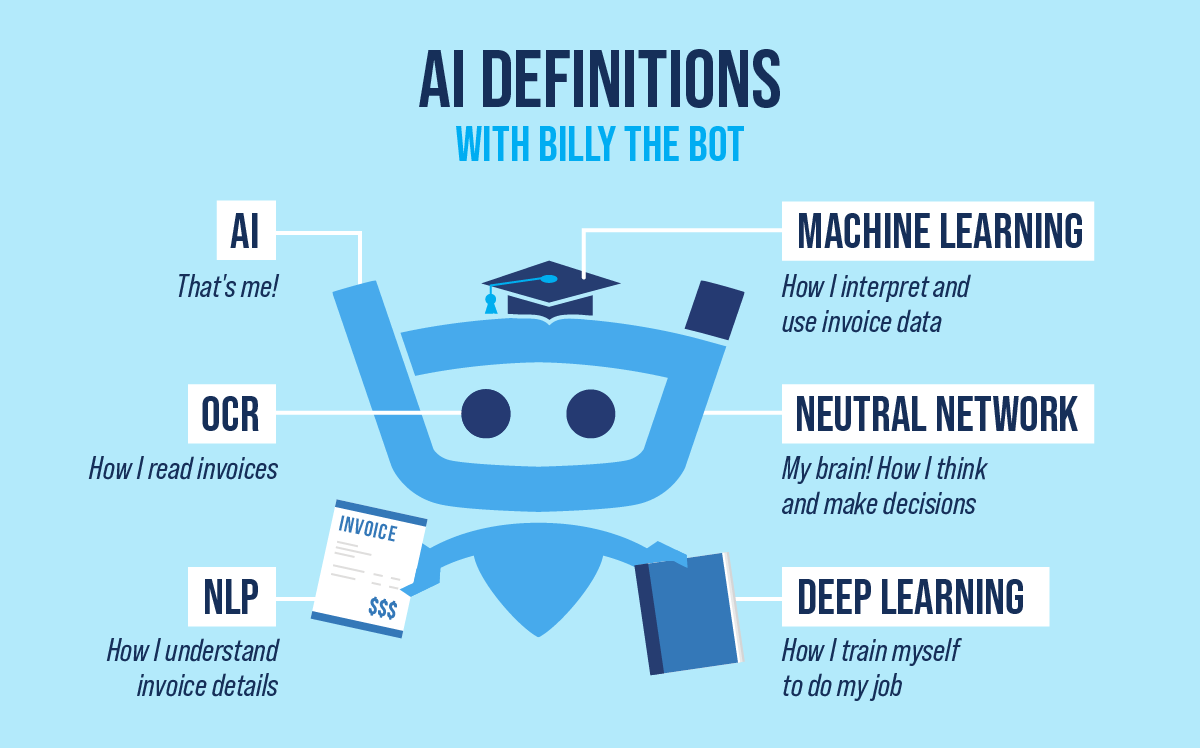
Neural networks
Neural networks, or neural nets, are the foundation of deep learning systems. My neural net is my brain – a technological system that mimics how the human brain works. Neural networks are great at recognizing patterns and are the backbone of systems like natural language processing (NLP), image recognition, and speech recognition.
Natural language processing
Natural language processing, or NLP, lets a computer or app understand text and spoken words like humans do. For example, AP systems use NLP to extract and understand relevant invoice data like vendor names, PO numbers, and product descriptions, even if that info is presented in different languages or fonts.
Optical character recognition
Optical character recognition, or OCR, isn’t really an AI technology, but it helps me do my job. OCR lets me read documents and recognize words and numbers. Using OCR, I can quickly scan digital and paper invoices to save your AP department a lot of processing time.
Now let’s look at structured and unstructured data types.
Types of data structures
Data structure is how data is organized, stored, and presented. Organizations use two main categories of data: structured and unstructured data. Each is sourced, collected, and organized in different ways. Since accounts payable departments manage a lot of structured and unstructured data, it’s important to know the difference between them and how it impacts AI-powered invoice processing.
Structured data
Structured data, or quantitative data, is highly organized and can easily be read and understood by machines. Generally, structured data is managed with a structured query language (SQL) via tools such as templates and SQL databases. Examples of structured data are accounting records, dates, and addresses. One way of looking at AI-empowered AP solutions is that they interpret and convert unstructured data sources, such as invoices, into structured data sets, such as vendor records or financial accounts.
Unstructured data
Unstructured data, or qualitative data, doesn’t have a predefined format and can’t easily be processed by machines. Examples of unstructured data include invoices, emails, and text messages. AI-powered AP solutions use machine learning algorithms to learn how to process unstructured data and perform complex tasks like 3-way invoice matching.
As I mentioned earlier, invoices are becoming increasingly complex, and so is the task of processing them. However, with the integration of AI and ML technologies, AP automation solutions powered by AI can simplify repetitive tasks such as invoice scanning and coding, resulting in more efficient invoice processing. Let’s explore how AI collaborates with AP teams to streamline AP workflows.
How automated invoice processing works
AI-powered invoice processing replaces manual invoice processing by automatically capturing and classifying unstructured invoice data from paper, email, and digital invoices, validating invoices, and managing approvals.
Here are five key ways AI can optimize a typical AP workflow.
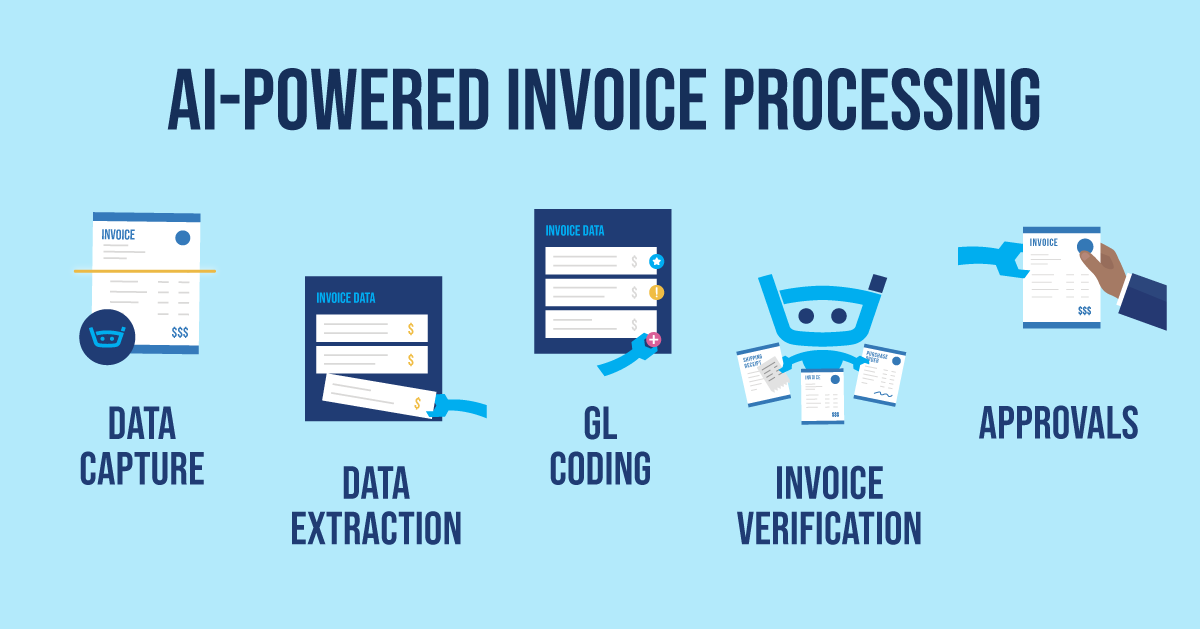
Data capture
With the help of OCR technology, I can quickly and accurately scan and digitize invoice data, including invoice numbers, vendor names, prices, PO numbers, line item descriptions, and taxes. The best part is I can handle a lot of invoices and invoice formats at once, eliminating the need for slow manual data entry and avoiding backlogs or late payments.
Data extraction
Once I have the invoices, I use NLP technology to understand, extract, and classify the invoice data accurately. For example, I can identify and extract data fields like vendor name, due date, amount due, and payment terms and line item information like product descriptions, unit prices, and quantities.
If I’m unsure about the accuracy of the invoice data, I can flag it and send it to an AP team member for a manual check. Once I’ve extracted and classified the data, I can share it with an ERP or accounting system.
GL coding
After I’ve extracted and classified the invoice data, I go through the line items and assign them the correct general ledger (GL) codes. I use machine learning to figure out which codes to use, but if I come to an item where I don’t know the code, I’ll make a suggestion and flag the code for a member of the AP team to check it out. I can also figure out if a line item needs a special GL code. For example, I can assign GL codes by department, project, or category.
Invoice verification
Once I’ve entered and GL-coded the invoice data, I can perform 3-way matching to check the accuracy of the invoice against the purchase order and shipping receipt. To do this, I find the right purchase order and receipt and check all the details to make sure they match. If they do, I forward the invoice for approval. If they don’t match, I flag the discrepancy for the AP team to investigate.
Approvals
When I’ve successfully verified the invoice is accurate, I can route it to the appropriate approver (or approvers) for approval. As I go, I learn the company’s approval process based on financial policies and past invoice approval history. For example, I can look at the invoice amount or vendor name and know which approval chain it must follow.
I can also follow up with approvers within a certain period to remind them of invoices sitting in the approval queue to make invoices get approved in time.
Now that we know how AI-powered invoice processing works let’s talk about some of the ways it can benefit your business.
Benefits of AI-powered invoice automation
By automating time-consuming and error-prone tasks, AI-powered invoice processing helps process invoices more quickly and accurately, saving time and money. Let’s look at some of the other significant benefits you can realize with AI:
Improved bottom line and cash flow
Because AI-powered processing is faster and more accurate than manual processes, businesses can realize significant time and cost savings. In addition, faster processing means faster supplier payments, which cuts back on late-payment fees and lets you take advantage of early payment discounts.
Prevent fraud and errors
I can identify errors and signs of fraud that human employees can miss, like slight differences in invoice details or duplicate line items. By detecting and flagging discrepancies, I make it a lot easier for your AP team to fight fraud.

Better accuracy and compliance
I learn as I go, which helps me get faster and more accurate with every invoice I process. Because I can ensure data accuracy, I can help your business stay compliant with regulations, including tax laws and reporting requirements.
Enhanced data transparency and sharing
AI-powered invoice processing lets you easily access and analyze real-time transaction data and perform analyses and forecasts. It also automatically syncs and shares data with ERPs, accounting software, and other business applications, allowing your business to make informed decisions.
Finally, let’s talk about some best practices you can follow to get the most out of your AI invoice processing solution.
Best practices for using AI-powered invoice processing
Moving to AI-powered invoice processing can drive evolutionary change for your business. Here are some best practices to follow to ensure you get optimal performance.
Trustworthiness & security
Your AI will handle sensitive data like vendor information, prices, and financial data. Ensure the system is secure and complies with regulatory requirements. Also, your AI must be trustworthy and transparent. Errors and incorrect decisions could cost your business money due to erroneous payments, exposure to fraud, or liability. Carefully vet any AI invoice processing solution to make sure it’s secure and trustworthy.
Assess your current workflows
Before implementing an AI-powered AP solution, look at your existing P2P workflows to identify tasks and areas where automation could benefit your business. This can include bottlenecks, critical tasks like invoice matching, and repetitive, error-prone processes.
Keep a human in the loop
AI automation can dramatically improve invoice management workflows, but it can’t take over every task. When you review your current workflows, identify tasks that still need human intervention. For example, it’s advisable to have a responsible employee approve invoices and supplier payments. By keeping a human in the loop, you can prevent expensive mistakes.
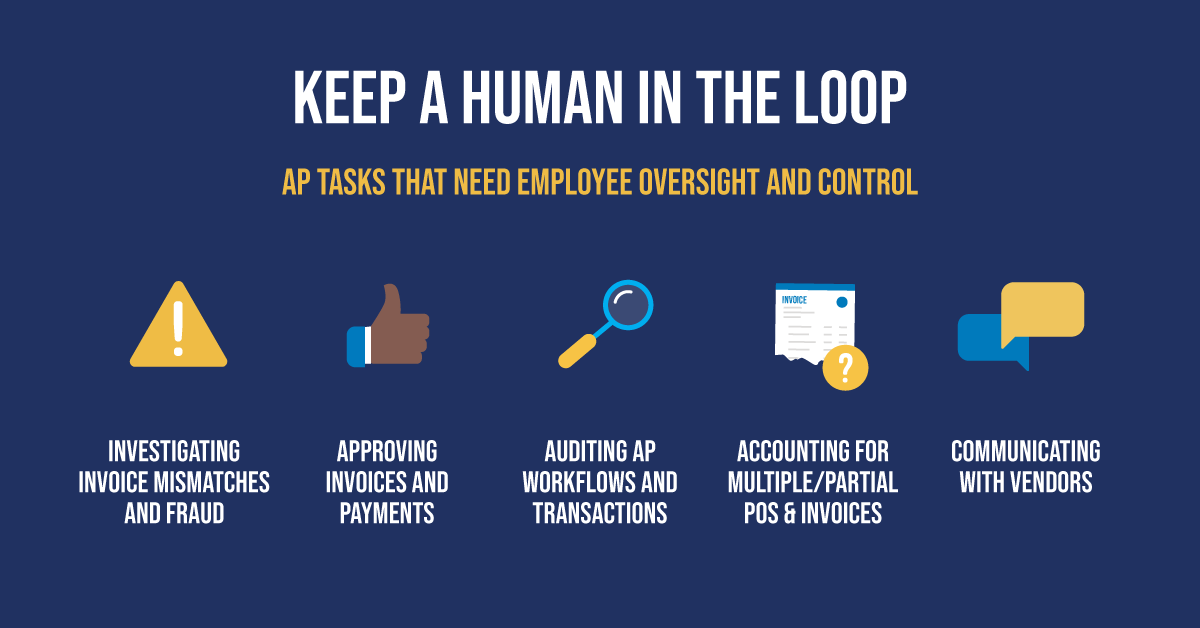
Testing & monitoring
Thoroughly test your AI invoice processing system after implementation to ensure that it works correctly. Your test plan should include manual and automated testing to identify and remedy any issues. Once the system is up and running, it’s important to keep an eye on its performance and make any necessary adjustments to enhance its efficiency and accuracy.
Integrate with business systems
I integrate with ERPs and accounting systems, which lets me share data and communications with everyone in the organization. When considering an AI-powered invoice management system, ensure that it offers seamless API integration with your existing business systems.
Choose the right AI invoice processing provider
Choose the AI-powered invoice processing solution that best meets your needs. Look carefully at IT requirements, functionality, cost, and efficiency, but also consider important factors like customer service, implementation time, scalability, and user-friendliness. Review-based rating sites like G2 can be a great resource in your search.
AI-powered invoice processing is an evolutionary technology that is only getting more powerful and flexible. By following the tips and advice in this article, you can streamline your P2P workflows and turn AP into a strategic engine for your business.
Stampli: The leader in AI-powered AP Automaton
Stampli is the only purpose-built AI-powered AP automation solution. It centers all communication, documentation, and workflows on top of each invoice, eliminating the need for workarounds, external communications channels, 3rd-party solutions, or manual AP work inside the ERP.
Stampli gives AP teams full visibility into the status of every single invoice and payment. Every activity in Stampli is logged and auditable, making month-end close simple and efficient.
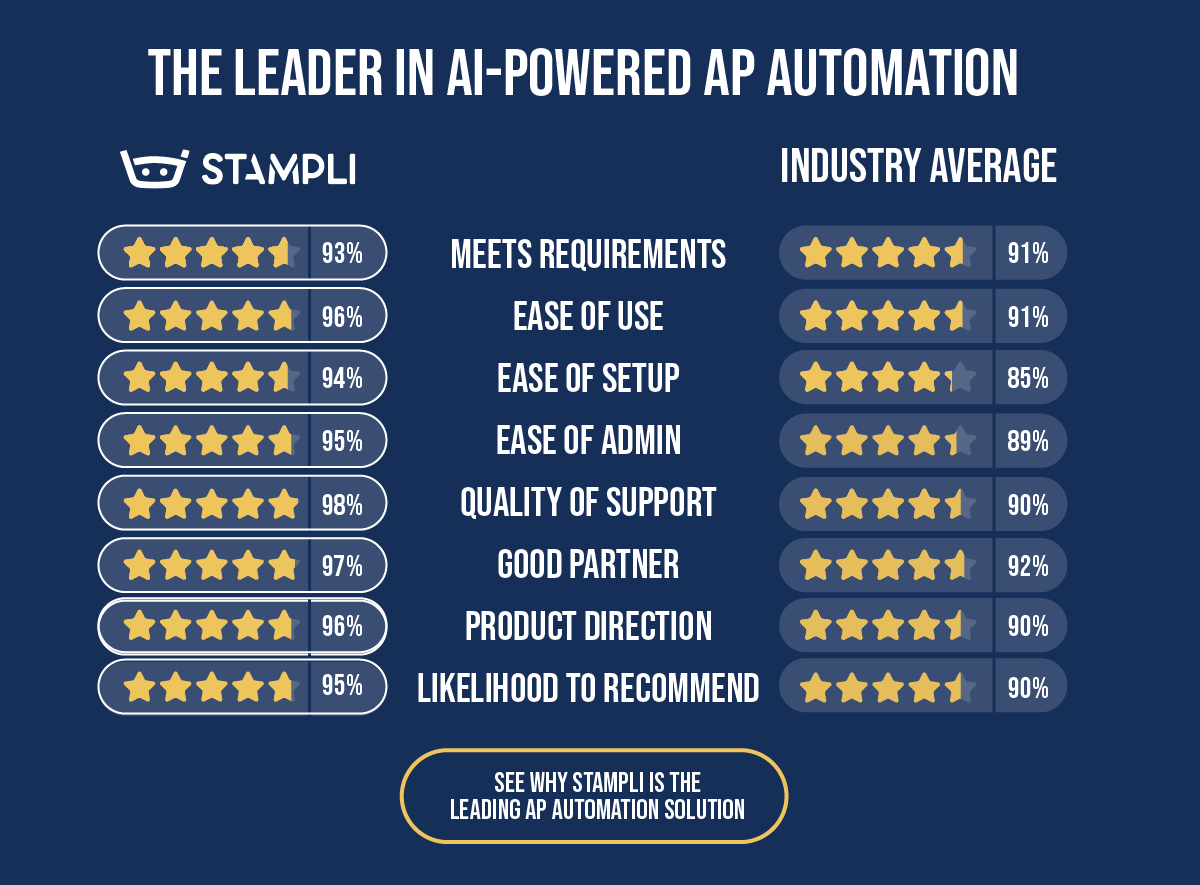
Empower Accounts Payable with Billy the Bot
AP teams dramatically reduce tedious manual tasks with the help of Billy the Bot™, Stampli’s AI-powered automation. Billy quickly learns how your business accounts payable processes work to automate your most time-consuming activities, including invoice capture, coding, approvals, fraud detection, and automatic sync of invoice data to your ERP system.
Stampli supports all native functionality for more than 70 ERPs, including those from Sage, Microsoft, SAP, Oracle, QuickBooks, and 70 others, enabling it to deploy in a matter of weeks, not months. To set up a free demo, contact Stampli today!
